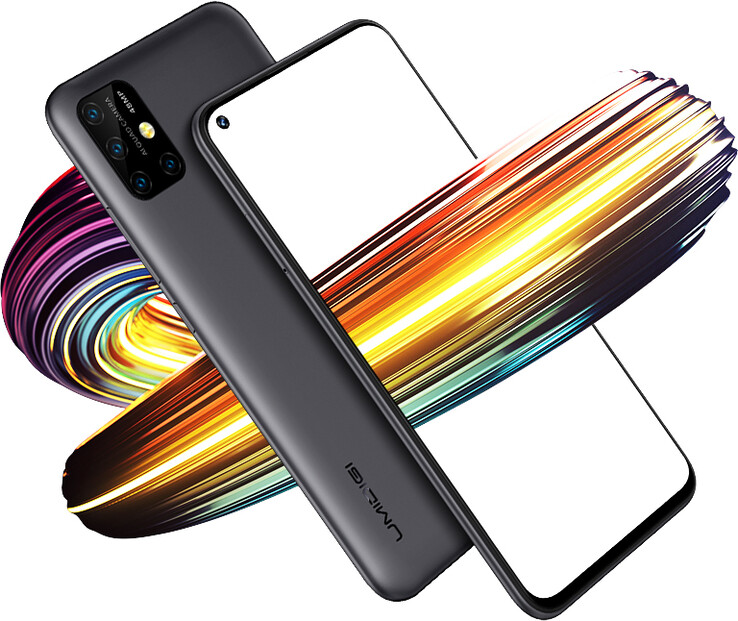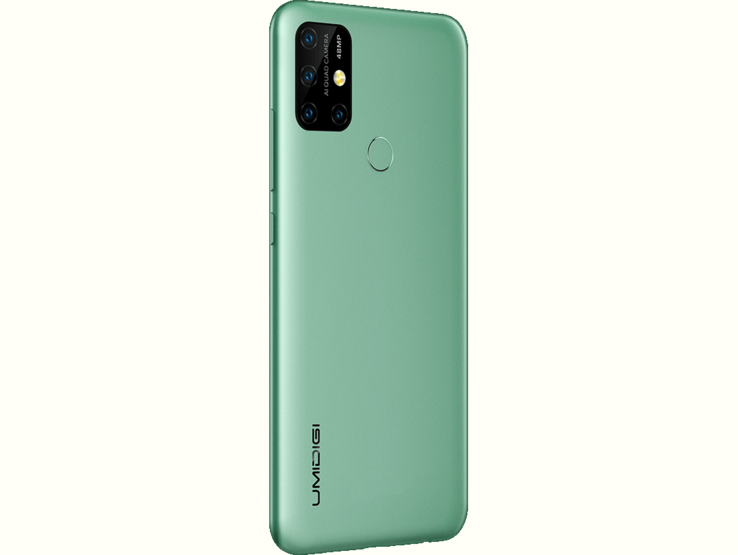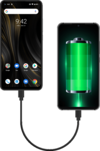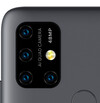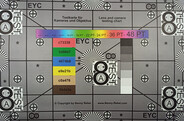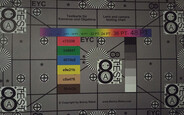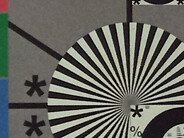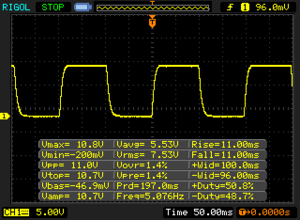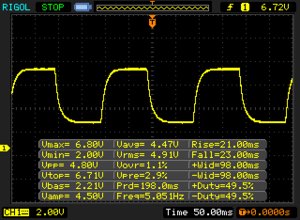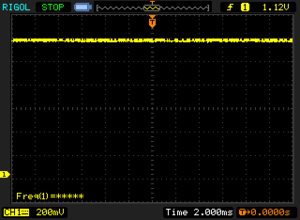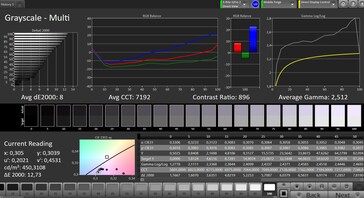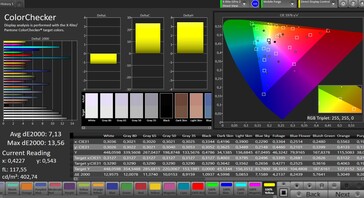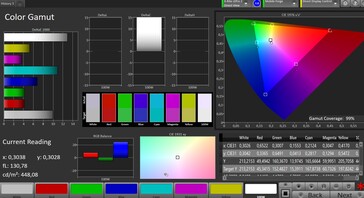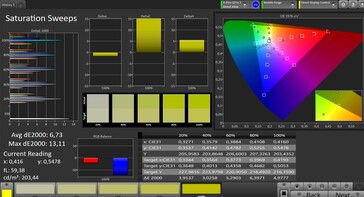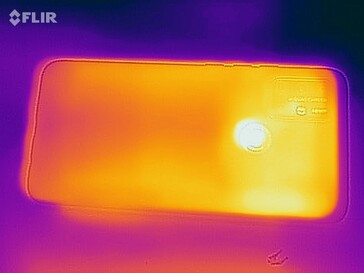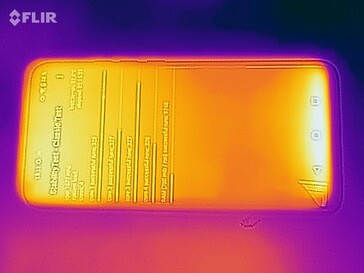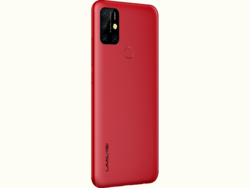Umidigi Power 3 Smartphone Review - Cellphone with Giant Battery and Wide-angle Camera
Comparison Devices
Bewertung | Rating Version | Datum | Modell | Gewicht | Laufwerk | Groesse | Aufloesung | Preis ab |
|---|---|---|---|---|---|---|---|---|
| 77.5 % v7 (old) | v7 (old) | 04 / 2020 | Umidigi Power 3 Helio P60, Mali-G72 MP3 | 218 g | 64 GB eMMC Flash | 6.53" | 2340x1080 | |
| 78.1 % v7 (old) | v7 (old) | 03 / 2020 | Motorola Moto G8 Power SD 665, Adreno 610 | 197 g | 64 GB eMMC Flash | 6.40" | 2300x1080 | |
| 79 % v7 (old) | v7 (old) | 01 / 2020 | Huawei P30 Lite New Edition Kirin 710, Mali-G51 MP4 | 159 g | 256 GB UFS 2.1 Flash | 6.15" | 2312x1080 | |
| 79.3 % v7 (old) | v7 (old) | 01 / 2020 | Xiaomi Redmi Note 8T SD 665, Adreno 610 | 200 g | 64 GB eMMC Flash | 6.30" | 2340x1080 |
Case, Equipment and Operation - Outdated Security Patches
Umidigi is a Chinese manufacturer whose mostly cheap smartphones are also officially available in the West. The Umidigi Power 3 is in the lower middle class with just under 200 Euros, but it still offers a 4x camera, which for the first time on the data sheet doesn't differ that much from higher quality smartphone cameras. The smartphone also comes with a huge battery, a modern display with camera hole and a dedicated fingerprint sensor.
The plastic housing is available in mint green, red or black, has a matt back and is cleanly finished. However, pressure on the screen or on the back will be visible in the liquid crystal of the display. The smartphone fits well in the hand, but at 218 grams is not a lightweight.
The smartphone comes with WiFi 5 and is also on par with other smartphones with this standard, as we found out in our standardized test with the Linksys Nighthawk AX12 reference router. NFC, which can be used for contactless payment, for example, is also on board. There is also a microSD reader and 64 GB mass storage, which corresponds to the class level. The Power 3 is compatible with many LTE networks and can therefore be used in many countries around the world.
Android 10 is pre-installed, but the security patches are already six months old at the time of testing. So you shouldn't expect regular updates here.
The touchscreen is easy to use and there is a dedicated fingerprint sensor on the back, which reliably unlocks the smartphone after a short delay.
| Networking | |
| iperf3 transmit AX12 | |
| Xiaomi Redmi Note 8T | |
| Umidigi Power 3 | |
| Huawei P30 Lite New Edition | |
| Motorola Moto G8 Power | |
| iperf3 receive AX12 | |
| Xiaomi Redmi Note 8T | |
| Umidigi Power 3 | |
| Huawei P30 Lite New Edition | |
| Motorola Moto G8 Power | |
Cameras - Flexible System with Good Photos
The Umdigi Power 3 comes with four camera lenses, the main lens has a resolution of 48 megapixels, this resolution can also be used, but usually four pixels are combined into one for higher light sensitivity. The fact that the camera is somewhat simpler than on high-end smartphones can be seen in the simple phase comparison autofocus and the maximum video quality in Full HD, but photos become quite decent in good light: in the focus area the sharpness is right and the pictures are quite brightly exposed. In low light, sharpness and contrast are only moderate, but at least the brightening is quite good.
In our lab tests, colors look a little pale and the sharpness is OK, but not at the highest level. There is visible image noise in low light, but overall the brightening here is surprisingly good for such a cheap smartphone.
It's nice that you can also zoom thanks to the wide-angle lens, but there is no continuous zoom between the lenses, instead you have to select the wide-angle lens separately before taking the picture. The same applies to the macro lens, with which you can get closer to an object at 3 centimetres. The fourth lens is used to calculate the depth of field and cannot take pictures of its own.
The front camera with 16 megapixels also takes decent pictures with quite a lot of details.
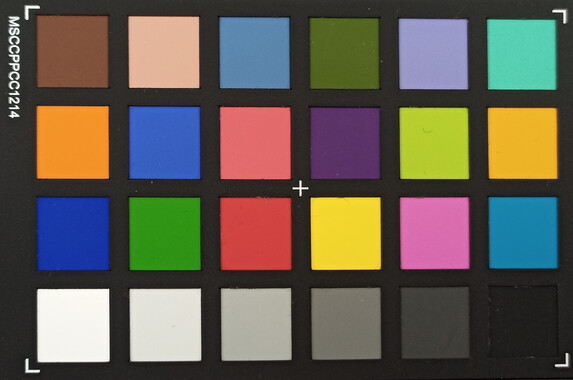
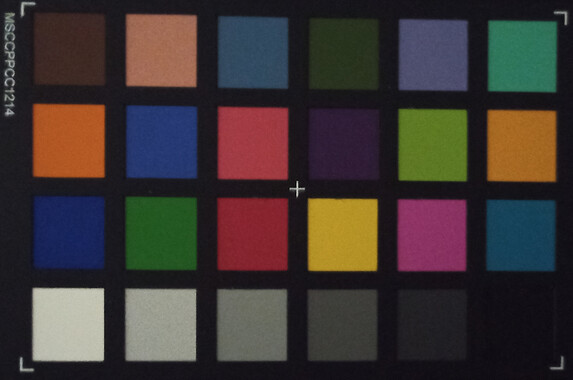
Display - Umidigi Screen Could Be Brighter
The IPS display resolves with extended Full HD resolution, but is a bit weaker than the competition in terms of brightness. 450 cd/m² on average is still OK on its own and is sufficient for shady places, even outdoors. The contrast ratio of 963:1 is rather moderate, so that colors look quite pale.
The color accuracy that we tested in our test with the spectrophotometer and the CalMAN software is also rather moderate, and here we also notice a blue cast visible to the naked eye. Specially the brighter blue tones deviate clearly from the reference colors.
| |||||||||||||||||||||||||
Brightness Distribution: 91 %
Center on Battery: 443 cd/m²
Contrast: 963:1 (Black: 0.46 cd/m²)
ΔE ColorChecker Calman: 7.13 | ∀{0.5-29.43 Ø4.77}
ΔE Greyscale Calman: 8 | ∀{0.09-98 Ø5}
99% sRGB (Calman 2D)
Gamma: 2.512
CCT: 7192 K
| Umidigi Power 3 IPS, 2340x1080, 6.5" | Motorola Moto G8 Power IPS, 2300x1080, 6.4" | Huawei P30 Lite New Edition IPS, 2312x1080, 6.2" | Xiaomi Redmi Note 8T IPS, 2340x1080, 6.3" | |
|---|---|---|---|---|
| Response Times | -12% | -5% | -47% | |
| Response Time Grey 50% / Grey 80% * (ms) | 44 ? | 46 ? -5% | 44 ? -0% | 56 ? -27% |
| Response Time Black / White * (ms) | 22 ? | 26 ? -18% | 24 ? -9% | 36.8 ? -67% |
| PWM Frequency (Hz) | 714 ? | 893 ? | ||
| Screen | 2% | 23% | 35% | |
| Brightness middle (cd/m²) | 443 | 462 4% | 507 14% | 628 42% |
| Brightness (cd/m²) | 450 | 483 7% | 481 7% | 631 40% |
| Brightness Distribution (%) | 91 | 93 2% | 88 -3% | 93 2% |
| Black Level * (cd/m²) | 0.46 | 0.65 -41% | 0.38 17% | 0.54 -17% |
| Contrast (:1) | 963 | 711 -26% | 1334 39% | 1163 21% |
| Colorchecker dE 2000 * | 7.13 | 5.7 20% | 4.72 34% | 2 72% |
| Colorchecker dE 2000 max. * | 13.56 | 8.9 34% | 7.84 42% | 5.1 62% |
| Greyscale dE 2000 * | 8 | 6.5 19% | 5.5 31% | 3.7 54% |
| Gamma | 2.512 88% | 2.303 96% | 2.158 102% | 2.17 101% |
| CCT | 7192 90% | 8073 81% | 7596 86% | 6230 104% |
| Total Average (Program / Settings) | -5% /
-0% | 9% /
17% | -6% /
18% |
* ... smaller is better
Display Response Times
| ↔ Response Time Black to White | ||
|---|---|---|
| 22 ms ... rise ↗ and fall ↘ combined | ↗ 11 ms rise | |
| ↘ 11 ms fall | ||
| The screen shows good response rates in our tests, but may be too slow for competitive gamers. In comparison, all tested devices range from 0.1 (minimum) to 240 (maximum) ms. » 47 % of all devices are better. This means that the measured response time is similar to the average of all tested devices (20.2 ms). | ||
| ↔ Response Time 50% Grey to 80% Grey | ||
| 44 ms ... rise ↗ and fall ↘ combined | ↗ 21 ms rise | |
| ↘ 23 ms fall | ||
| The screen shows slow response rates in our tests and will be unsatisfactory for gamers. In comparison, all tested devices range from 0.165 (minimum) to 636 (maximum) ms. » 73 % of all devices are better. This means that the measured response time is worse than the average of all tested devices (31.6 ms). | ||
Screen Flickering / PWM (Pulse-Width Modulation)
| Screen flickering / PWM not detected | |||
In comparison: 53 % of all tested devices do not use PWM to dim the display. If PWM was detected, an average of 8081 (minimum: 5 - maximum: 343500) Hz was measured. | |||
Performance, Emissions and Battery Life - Good Performance
The MediaTek Helio P60 as a SoC is a solid choice for an affordable mid-range smartphone. It may not be quite dewy anymore, but it can even easily outperform the comparable devices. You shouldn't expect the Umidigi Power 3 to have very elaborate apps, but in everyday life you can navigate through the system relatively smoothly and for less complex activities like watching videos or scrolling through pictures, the smartphone has completely sufficient power. It should also be sufficient for simple gaming.
You shouldn't expect any speed records from the memory and the microSD reader disappoints because it doesn't even recognize our reference microSD Toshiba Exceria Pro M501. The speeds are rather moderate with the replacement card.
The loudspeaker in our test device was hardly usable: very quiet, dull and rattling. Maybe it was broken in our test device, but it's still not a good sign for quality.
The Umidigi mobile phone gets noticeably warm under load with up to 42.7°C. This can be quite unpleasant in high ambient temperatures and when you carry the smartphone around in your trouser pocket. The warming never becomes critical, though.
The large battery also helps the Umidigi Power 3 to very good runtimes of 18:44 hours in our WLAN test. This speaks for 3 working days without charging, if you don't put too much strain on the smartphone. The charger with up to 18 watts needs its 2 hours to fully recharge the large battery.
| PCMark for Android | |
| Work performance score (sort by value) | |
| Umidigi Power 3 | |
| Motorola Moto G8 Power | |
| Huawei P30 Lite New Edition | |
| Average Mediatek Helio P60 (8609 - 11387, n=7) | |
| Work 2.0 performance score (sort by value) | |
| Umidigi Power 3 | |
| Motorola Moto G8 Power | |
| Huawei P30 Lite New Edition | |
| Xiaomi Redmi Note 8T | |
| Average Mediatek Helio P60 (6934 - 7954, n=7) | |
| GFXBench | |
| on screen Aztec Ruins Normal Tier Onscreen (sort by value) | |
| Umidigi Power 3 | |
| Motorola Moto G8 Power | |
| Huawei P30 Lite New Edition | |
| Xiaomi Redmi Note 8T | |
| Average Mediatek Helio P60 (6.6 - 8.6, n=7) | |
| Average of class Smartphone (6.2 - 166, n=208, last 2 years) | |
| 1920x1080 Aztec Ruins Normal Tier Offscreen (sort by value) | |
| Umidigi Power 3 | |
| Motorola Moto G8 Power | |
| Huawei P30 Lite New Edition | |
| Xiaomi Redmi Note 8T | |
| Average Mediatek Helio P60 (6.2 - 8.3, n=7) | |
| Average of class Smartphone (3.4 - 367, n=208, last 2 years) | |
| on screen Aztec Ruins High Tier Onscreen (sort by value) | |
| Umidigi Power 3 | |
| Motorola Moto G8 Power | |
| Huawei P30 Lite New Edition | |
| Xiaomi Redmi Note 8T | |
| Average Mediatek Helio P60 (2.6 - 6.4, n=7) | |
| Average of class Smartphone (0.85 - 144, n=209, last 2 years) | |
| 2560x1440 Aztec Ruins High Tier Offscreen (sort by value) | |
| Umidigi Power 3 | |
| Motorola Moto G8 Power | |
| Huawei P30 Lite New Edition | |
| Xiaomi Redmi Note 8T | |
| Average Mediatek Helio P60 (2.1 - 4.3, n=7) | |
| Average of class Smartphone (1.2 - 146, n=208, last 2 years) | |
| Umidigi Power 3 | Motorola Moto G8 Power | Huawei P30 Lite New Edition | Xiaomi Redmi Note 8T | Average 64 GB eMMC Flash | Average of class Smartphone | |
|---|---|---|---|---|---|---|
| AndroBench 3-5 | 171% | 310% | 140% | 83% | 935% | |
| Sequential Read 256KB (MB/s) | 290.5 | 300.9 4% | 800 175% | 315.8 9% | 277 ? -5% | 2235 ? 669% |
| Sequential Write 256KB (MB/s) | 207.8 | 181.9 -12% | 391.1 88% | 173.9 -16% | 178.4 ? -14% | 1871 ? 800% |
| Random Read 4KB (MB/s) | 78.5 | 57.7 -26% | 198.7 153% | 90.4 15% | 60.7 ? -23% | 297 ? 278% |
| Random Write 4KB (MB/s) | 16.4 | 132.6 709% | 171.6 946% | 91.2 456% | 33.8 ? 106% | 343 ? 1991% |
| Sequential Read 256KB SDCard (MB/s) | 39.6 ? | 69.4 ? 75% | 76.6 ? 93% | 71.6 ? 81% | 77.4 ? 95% | |
| Sequential Write 256KB SDCard (MB/s) | 13.3 ? | 49.7 ? 274% | 66.8 ? 402% | 52.8 ? 297% | 58.3 ? 338% |
Temperature
(±) The maximum temperature on the upper side is 42.7 °C / 109 F, compared to the average of 35.2 °C / 95 F, ranging from 21.9 to 247 °C for the class Smartphone.
(±) The bottom heats up to a maximum of 42.4 °C / 108 F, compared to the average of 34 °C / 93 F
(+) In idle usage, the average temperature for the upper side is 30 °C / 86 F, compared to the device average of 32.9 °C / 91 F.
Speakers
Umidigi Power 3 audio analysis
(±) | speaker loudness is average but good (75.8 dB)
Bass 100 - 315 Hz
(-) | nearly no bass - on average 53.3% lower than median
(+) | bass is linear (0% delta to prev. frequency)
Mids 400 - 2000 Hz
(-) | nearly no mids - on average 53.3% lower than median
(+) | mids are linear (0% delta to prev. frequency)
Highs 2 - 16 kHz
(-) | nearly no highs - on average 53.3% lower than median
(+) | highs are linear (0% delta to prev. frequency)
Overall 100 - 16.000 Hz
(-) | overall sound is not linear (131.7% difference to median)
Compared to same class
» 99% of all tested devices in this class were better, 1% similar, 0% worse
» The best had a delta of 11%, average was 35%, worst was 134%
Compared to all devices tested
» 100% of all tested devices were better, 0% similar, 0% worse
» The best had a delta of 4%, average was 24%, worst was 134%
Xiaomi Redmi Note 8T audio analysis
(+) | speakers can play relatively loud (87.9 dB)
Bass 100 - 315 Hz
(-) | nearly no bass - on average 25.6% lower than median
(±) | linearity of bass is average (11.3% delta to prev. frequency)
Mids 400 - 2000 Hz
(+) | balanced mids - only 3.2% away from median
(+) | mids are linear (3.4% delta to prev. frequency)
Highs 2 - 16 kHz
(±) | higher highs - on average 6.3% higher than median
(+) | highs are linear (3.1% delta to prev. frequency)
Overall 100 - 16.000 Hz
(±) | linearity of overall sound is average (18.6% difference to median)
Compared to same class
» 21% of all tested devices in this class were better, 9% similar, 70% worse
» The best had a delta of 11%, average was 35%, worst was 134%
Compared to all devices tested
» 41% of all tested devices were better, 8% similar, 51% worse
» The best had a delta of 4%, average was 24%, worst was 134%
Battery Life
| Umidigi Power 3 6150 mAh | Motorola Moto G8 Power 5000 mAh | Huawei P30 Lite New Edition 3340 mAh | Xiaomi Redmi Note 8T 4000 mAh | Average of class Smartphone | |
|---|---|---|---|---|---|
| Battery Runtime | |||||
| WiFi Websurfing (h) | 18.7 | 16.7 -11% | 12 -36% | 12.7 -32% | 19.3 ? 3% |
Pros
Cons
Verdict – With Quirks, But Good Running Time
For its 199 Euros, the Umidigi Power 3 offers suitable performance figures, long battery life and a good camera setup. The pictures are quite decent for the price range, especially under low light, and can also convince under normal lighting. Sure, you shouldn't expect a high-end solution, but those who scale back their demands a bit will be quite satisfied.
You shouldn't expect the latest security patches, the device can get quite warm and the loudspeaker is rather a stopgap, but here the necessary savings measures are evident. Also, the screen isn't as bright and colors are displayed rather inaccurately. The microSD reader also worked rather moderately in our test and the internal memory is not particularly fast.
The Umidigi Power 3 has its quirks, but offers very good battery life and a decent camera for little money.
But if you are looking for a cheap Smarpthone with decent battery life, a more flexible camera with decent image quality and quite a fast WLAN, you will be satisfied.
Umidigi Power 3
- 04/23/2020 v7 (old)
Florian Schmitt


